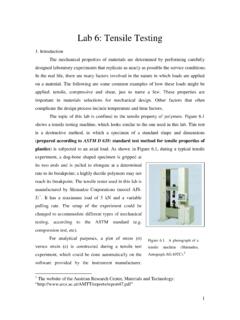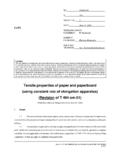Transcription of PROCEDURE FOR FSEL TENSILE TESTING OF REINFORCING …
1 FSEL PROCEDURE FOR TENSILE TESTING OF REINFORCING BARS Rev. 2 1 1. PROCEDURE OVERVIEW This FSEL test standard is used to determine the TENSILE properties of REINFORCING bars. The TESTING is in general conformance with ASTM A370-15 Standard Test Methods and Definition for Mechanical TESTING of Steel Products (Ref ) and ASTM A615-16 Standard Specification for Deformed and Plain Carbon-Steel Bars for Concrete Reinforcement (Ref. ). Appendix 9 to ASTM A370 specifically addresses TENSILE TESTING or REINFORCING bars. The PROCEDURE below uses the MTS test machine along with a pre-programmed test PROCEDURE . The pre-programmed test PROCEDURE should be adequate for most REINFORCING bar TESTING . Should any alteration be needed, consult with FSEL staff beforehand. Based on the original calibration records for this test machine, the peak error in force output was kN (290 lb).
2 An error of this magnitude could affect calculation of stresses for smaller diameter bars. If precise test results are needed for small diameter bars, a test frame with less force capacity may be preferable. Student Responsibilities for TESTING : Read and understand the requirements of this PROCEDURE Provide REINFORCING bar samples Provide shim materials for gripping small diameter bars Cleaning machine after TESTING Staff Responsibilities for TESTING : Read and understand the requirements of this PROCEDURE Provide students with keys to control and accessories cabinets Assist students with TESTING as needed 2. EQUIPMENT AND TOOLS MTS Test Machine MTS Extensometer Grips Ladder Rubber Bands or Springs USB drive Shimming Materials Small Bars 3. MATERIALS Steel Samples Grease FSEL PROCEDURE FOR TENSILE TESTING OF REINFORCING BARS Rev.
3 2 2 4. PERSONAL PROTECTIVE EQUIPMENT Safety Glasses Safety Shoes Hardhat Hearing Protection Disposable Rubber Gloves 5. DETAILED PROCEDURE Identify the REINFORCING bars to be tested and cut them to a length of approximately 30 in. The number of samples is to be determined by the research team. Typically, three samples are tested for each bar size used in the test program. The grips for the test machine are 7 in. long and ASTM A370 requires an 8 in. or 200 mm minimum gage length. Using a specimen of a length different from 30 in. could affect the loading rate for the specimen. Remove any burs or sharp edges that may result from cutting the bars. Obtain the keys to the control cabinet and the cabinet containing the MTS test accessories. The key to the control cabinet is located in the gray storage cabinet in the lab manager s office.
4 All FSEL staff members have a key to the accessories cabinet. Prepare the extensometer for TESTING . The extensometer and its accessories are contained in two black plastic cases locked in the gray cabinet near the test machine. The larger case contains the extensometer, a user manual, a plastic bag with drawings, and a small plastic case that contains spare parts, tools, rubber bands, and springs. The smaller case contains three extension bars and a small plastic case with additional parts and tools. Place the set pin in the extensometer. The set pin is used to hold the extensometer at a fixed opening distance prior to attaching the extensometer to the specimen. This pin prevents over-extending or over-compressing the instrument during setup. Add the gage length extender to the extensometer.
5 The default gage length of the extensometer is 50 mm ( in.). This gage length can be extended to 200 mm ( in.) by inserting a gage length extender. Note that the standard gage length per ASTM A370 is either 8 in. or 200 mm. A technical drawing FSEL PROCEDURE FOR TENSILE TESTING OF REINFORCING BARS Rev. 2 3 showing the installed extender bar is inside the extender case (Reference ). Note that the gage length extender has a correct and an incorrect orientation. Ensure that all parts are installed on the extensometer as shown in the drawing. Install the knife edges appropriate for the specimen being tested. For round specimens, the straight knife edges should be used. Drawings of the knife edges are provided at left in Figure 1. Figure 1 Knife Edges for round specimens (left) and flat specimens (right) (Ref.)
6 Choose a method to attach the extensometer to the specimen being tested. There are three methods to attach the extensometer to the sample: Rubber Bands (Preferred Method): Rubber bands of various sizes can be attached to the small wire hooks on the sides of the extensometer as shown on Reference Choose rubber bands of the appropriate size to ensure firm contact between the knife edges of the extensometer and the specimen. Quick Attachment Spring: A steel attachment spring is attached to the extensometer connection points. This spring wraps around small diameter (< in.) sample to form the connection. The spring can be positioned at one of four locations to ensure the proper gripping pressure. Consult Reference to identify the correct spring position. FSEL PROCEDURE FOR TENSILE TESTING OF REINFORCING BARS Rev.
7 2 4 Coil Springs: Coil springs can be used in place of rubber bands as described above. The spring length should be sized to ensure firm contact between the knife edges of the extensometer and the specimen. Guidance on the proper spring length can be found in Reference Whichever method is chosen, MTS recommends a contact force between the knife edges and the specimen of approximately 600 g ( lb) per edge. The extensometer should not be attached to the coupon until after the coupon is installed in the test machine. See Article Make the electrical connection between the extensometer and the MTS test controller. The free end of the wire coming out of the control console is zip-tied to the southwest column of the test frame. This wire end should be connected to an intermediate wire that will then connect to the wire attached to the extensometer.
8 The intermediate wire should be stored in the gray cabinet near the machine. Initialize the computer and data acquisition system. Power on the system. Obtain the key to the control cabinet from a staff member. Unlock the tray containing the computer keyboard and mouse. The power switch to the computer is behind an additional locked panel. The key to this locked panel is typically left in place and should be visible after unlocking the keyboard tray. To power on the data acquisition, press the white toggle switch to I. The green light on the control panel below the switch should illuminate. To power on the pump, press the white button labeled as on exterior of the control cabinet. The white button should illuminate and the pump should be audibly running. If the red or yellow lights on the front of the control cabinet illuminate at any point in the test process, contact and FSEL staff member for assistance.
9 Start the MTS TestWare Elite Software. Double click on the MTS TestWare Elite icon ( ) on the desktop. Log in to the software as FSEL Student with the password: daq. FSEL PROCEDURE FOR TENSILE TESTING OF REINFORCING BARS Rev. 2 5 Load the test protocol. Click on Custom Templates on the left side of the screen. Double-click on FSEL Rebar TESTING Template to load the test protocol. Create a folder for your test data. On the computer desktop, there is a folder titled TestData . Create folder for your project within that folder. It is also recommended that you create a subfolder titled as the day of TESTING in YYYYMMDD format. These folders will help organize files for all projects. Save the test data. To avoid overwriting the test protocol at a later stage, it is recommended that you save the test at this stage of the PROCEDURE using MTS proprietary format.
10 Click on File Save As and navigate the folder created in Article It is recommended that you rename this file to something specific to your project. Reset interlocks. Reset the interlocks by clicking the reset button ( ). Interlocks are safety features that prevent the machine from applying load unless the system is ready. If an interlock is tripped, the box to the right of the reset button will be red and there may be additional red indicators in the Status portion of the menu bar. If any red indicators re-appear after clicking the reset button, contact FSEL technical staff for assistance. If the red or yellow lights on the front of the control cabinet illuminate at any point in the test process, contact any FSEL staff member for assistance. Set the test platen position to the correct initial position.




